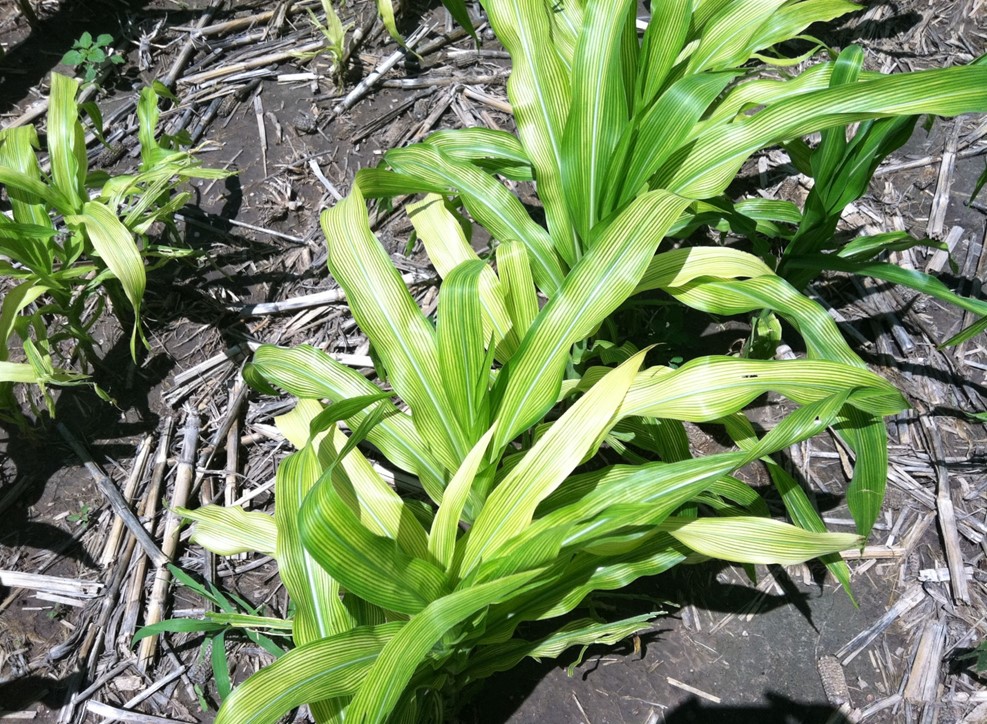Manganese Antagonism from High Iron in Soils
June 14, 2022
Nutrient Uptake Antagonism
Nutrient uptake antagonism refers to the competition between nutrients for uptake by plants. The two nutrients, often ions with the same charge, are said to be antagonistic with regard to the other.
When Iron (Fe) is very high in soils (greater than 125 ppm), the Fe interferes with the root uptake of Manganese (Mn). Both are positively charged ions and both are taken up (absorbed) by the roots by mass flow and root interception. Fe is also absorbed by diffusion. Both Mn and Fe are competing with each other to be taken up by the roots. When the soil contains large amounts of Fe, it prevents the up-take of Mn. This is true even when the levels of Mn in the soil are high (greater than 6 ppm).
How Nutrients are Taken Up by the Roots
Mass flow is the movement of dissolved nutrients into a plant as the plant absorbs water for transpiration. The process is responsible for most transport of nitrate, sulfate, calcium and magnesium.
Diffusion is the movement of nutrients to the root surface in response to a concentration gradient. When nutrients are found in higher concentrations in one area than another, there is a net movement to the low-concentration area so that equilibrium is reached. Thus, a high concentration in the soil solution and a low concentration at the root cause the nutrients to move to the root surface, where they can be taken up. This is important for the transport of phosphorus and potassium.
Root interception occurs when growth of a root causes contact with soil colloids which contain nutrients. The root then absorbs the nutrients. It is an important mode of transport for calcium and magnesium but, in general, is a minor pathway for nutrient transfer.

Manganese deficient corn
| Nutrient | Mass Flow | Diffusion | Root Interception |
| Nitrogen | X | ||
| Phosphorus | X | ||
| Potassium | X | X | |
| Calcium | X | X | |
| Magnesium | X | X | |
| Sulfur | X | X | |
| Boron | X | ||
| Copper | X | ||
| Iron | X | X | X |
| Manganese | X | X | |
| Zinc | X | X | X |
| Molybdenum | X |
Solutions to Improve Mn Up-take in Soils High in Fe
- An in-furrow or 2X2 application at planting of EDTA Mn. The idea is to have a small area next to the plant roots where there is a high concentration of Mn. This will compensate for the high levels of Fe in the soil.
- Foliar application of Mn can by-pass the root uptake allowing the plants to uptake Mn through the leaves. Brandt’s Smart and Manni-Plex product lines both use a sugar alcohol delivery system to get Mn into the leaves. BRANDT Organiplex 4% Mn uses amino acids as a delivery system to get Mn into the leaves. Both delivery systems work excellent.
BRANDT Products, Timings and Rates
BRANDT Sequestar 13% Mn. EDTA Chelated Mn. 4-12lb/A. Applied In-furrow or 2X2 at Planting
BRANDT Sequestar 6% Mn. EDTA Chelated Mn. 2-8qt/A. Applied In-furrow or 2X2 at Planting
BRANDT Smart Mn (6%). Sugar Alcohol delivery system. 1-2qt/A. Applied during vegetative growth or reproductive growth. Can be applied multiple times in the growing season.
BRANDT Smart Mn Plus (4%). Sugar Alcohol delivery system. 1-2qt/A. Applied during vegetative growth or reproductive growth. Can be applied multiple times in the growing season.
BRANDT Manni-Plex Mn (5%). Sugar Alcohol delivery system. 1-2qt/A. Applied during vegetative growth or reproductive growth. Can be applied multiple times in the growing season.
BRANDT Organiplex 4% Mn (+ 0.25% B). Amino acid delivery system. 1-2qt/A. Applied during vegetative growth or reproductive growth. Can be applied multiple times in the growing season.
References Sited
Cornell University. “DESCRIBE HOW THE PROCESSES OF MASS FLOW, DIFFUSION, AND ROOT INTERCEPTION AFFECT NUTRIENT UPTAKE”. 2022 https://nrcca.cals.cornell.edu/nutrient/CA2/CA0209.php
